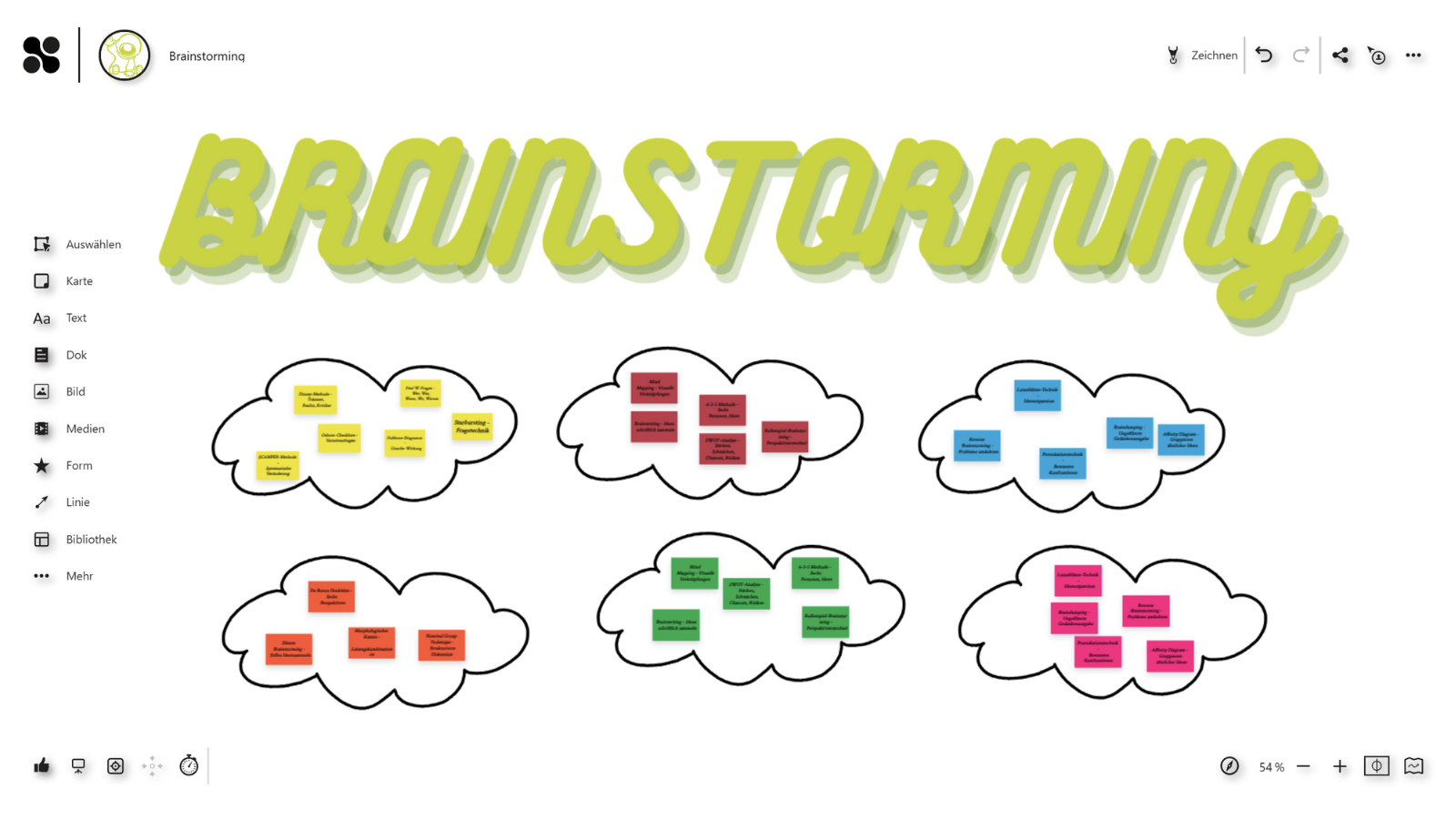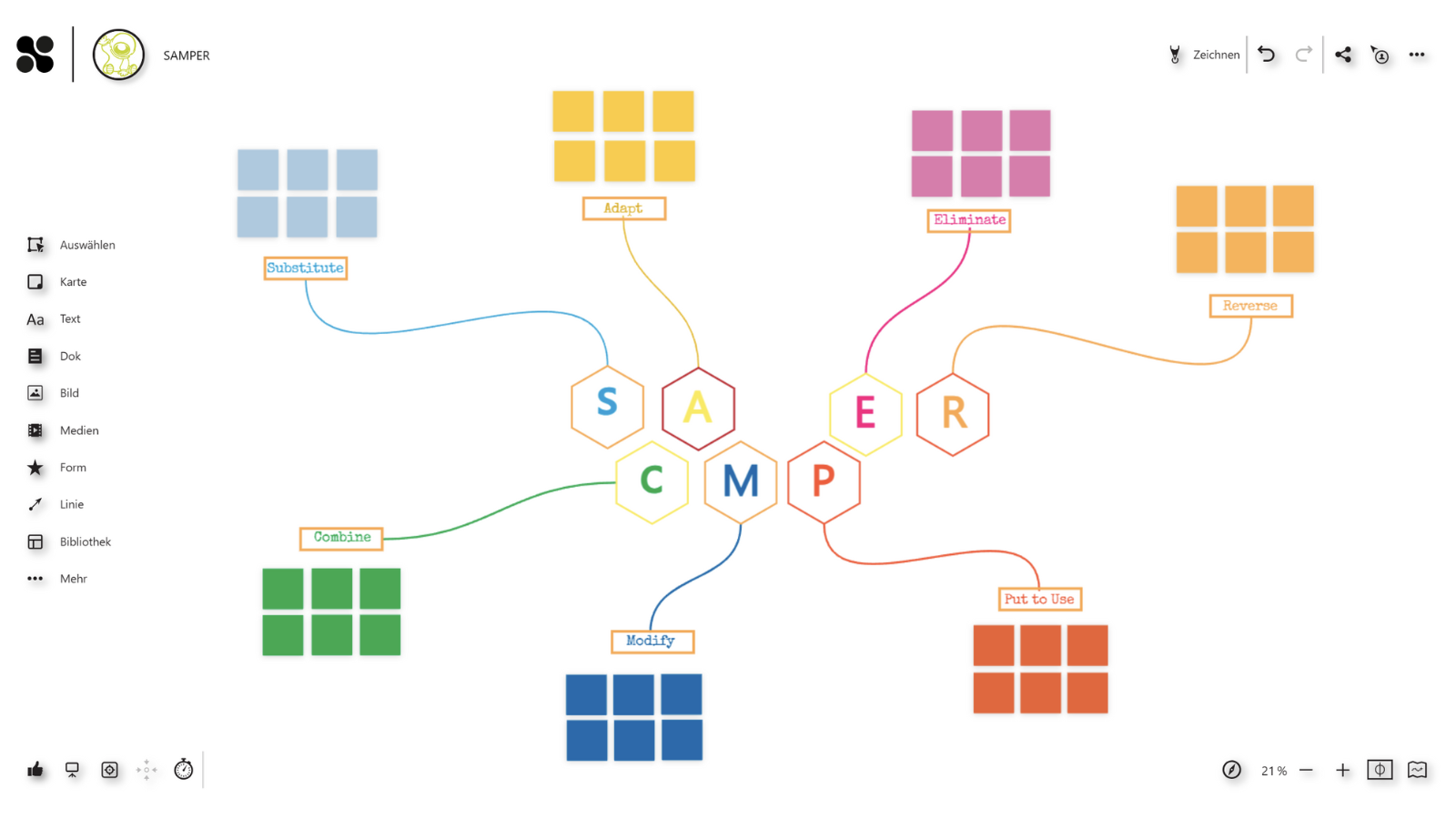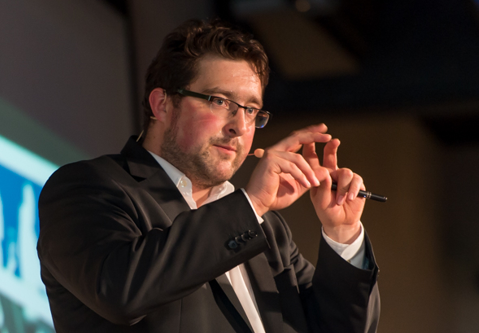In this article, we aim to explore various brainstorming methods. Initially, we'll briefly discuss what brainstorming is and why it's so crucial for creative processes.
Moreover, we will introduce you to both classic and modern brainstorming methods and answer the most common questions about these idea-generation techniques.
What is Brainstorming?
To begin, let's briefly define what brainstorming actually is.
Under the term 'brainstorming,' we understand various methods of idea generation. What's special about brainstorming is that all participants can share their ideas, and all ideas are collected. The ideas are simply noted down without judgment. Only after the brainstorming session does the evaluation and sorting of ideas follow.
Why Brainstorming is Crucial for Creative Processes
Creativity is key to innovation, and brainstorming is an excellent way to be creative. New ideas could mean the difference between success and stagnation, making brainstorming increasingly important. We have gathered some benefits of brainstorming for you:
-
Creative Output through Diversity: The variety of perspectives and ideas that come together during a brainstorming session is invaluable. Each person brings different experiences, knowledge, and approaches, leading to a broad spectrum of ideas.
-
Collective Problem-Solving: Brainstorming creates a space where team members can work together on challenges. Open exchange of ideas can solve difficulties in ways an individual might not achieve.
-
Enhancing Team Dynamics: Generating ideas together strengthens team dynamics. Brainstorming generates positive energy that fosters collaboration.
The Classics - Traditional Brainstorming Methods
Classic brainstorming is considered one of the most time-tested methods for idea generation. Developed by Alex F. Osborn in the 1940s, it is based on simple principles that promote creativity in groups. Let’s look at the fundamentals of classic brainstorming that make it so effective.
Fundamentals of Classic Brainstorming
The fundamentals that make classic brainstorming effective include:
-
Unfiltered Expression of Ideas: In classic brainstorming, team members meet to express ideas without any restrictions. The freedom to share thoughts without judgment creates a space for diverse concepts.
-
Quantity Over Quality: A key aspect of classic brainstorming is to gather a large number of ideas without worrying about perfection or feasibility. The focus is on quantity, which promotes creativity and encourages unconventional solutions.
-
Combination and Improvement: After collecting ideas, similar ideas and concepts are merged. Then, it’s considered how they can be combined and improved.
-
Short, Intense Sessions: Short, intense sessions promote spontaneity, encouraging participants to think quickly and effectively.
-
Moderator Role: A moderator leads classic brainstorming to ensure the rules are followed and a positive framework is created. Moderation promotes active participation and helps maintain focus.
-
Delaying Criticism: During brainstorming, any evaluation of ideas is avoided. This allows participants to focus on creative thinking without being hindered by potential negative reactions.
-
Visualization: Visualization plays a crucial role in classic brainstorming. Ideas are made tangible through sketches, diagrams, or mind maps, promoting better collaboration within the team.
These fundamentals make classic brainstorming a timeless tool for creative groups.
Method 1: Free Brainstorming
In free brainstorming, participants come together to spontaneously express ideas on a specific topic. There are no restrictions or criticisms during this phase. The focus is on the quantity of ideas, with the group's creativity taking the forefront. The ideas are collected and later analyzed or grouped.
Method 2: Mind Mapping
Mind Mapping is a visual technique where central ideas are placed in the middle of a whiteboard or flipchart. Branches are then created for subpoints and additional aspects. This method not only promotes creative thinking but also helps to illustrate relationships between different ideas. Mind maps are particularly useful in bringing structure to the richness of ideas.
Method 3: Reverse Brainstorming
In reverse brainstorming, the focus is on identifying problems or obstacles rather than seeking solutions. Participants consider a topic from the perspective of potential failures or difficulties. Subsequently, ideas are developed on how these problems can be avoided or overcome. This fosters critical thinking and allows for early identification of potential stumbling blocks.
Method 4: 6-3-5 Method
The 6-3-5 method is a structured form of brainstorming. Six participants each write down three ideas in five minutes on a given topic on a piece of paper. After each round, they pass their ideas on, and the next participants expand or modify the existing ideas.
This process repeats until each sheet has been processed by every participant. In the end, each idea has received input from all participants, leading to a broad range of creative approaches.
Method 5: Starbursting Method
This classic method can be used when you and your team focus on a single idea. Starbursting starts by writing an idea in the center of a whiteboard and drawing a hexagonal star around it. Each point of the star represents one of the 'W' questions:
- Who?
- What?
- When?
- Where?
- Why?
- How?
Each question is answered in relation to the idea. Questions might include, “When do we need to start the campaign?” or “Who is the target audience for this product?” This way, you can discover obstacles you hadn't thought of before.

The Evolution - Modern Brainstorming Methods
Brainstorming has undergone a remarkable evolution over time as creative thinking approaches and technologies advance. Modern brainstorming approaches go beyond traditional methods by adapting to the requirements of today's dynamic and digital world.
Key Changes in Brainstorming
The most important changes and innovations in brainstorming include:
-
Digital Brainstorming: With the development of digital tools, brainstorming has shifted from physical whiteboards and Post-its to online platforms. This allows teams to exchange ideas worldwide and collaborate in real-time. Chat functions, video conferencing, and cloud-based online whiteboards facilitate joint idea generation.
-
Gamification in Brainstorming: Modern approaches incorporate playful elements to increase participant motivation and engagement. Gamification in brainstorming can take the form of competitions, point systems, or interactive exercises. The playful approach lowers barriers and casually promotes creativity.
-
Design Thinking: Design Thinking is a methodological approach increasingly used in brainstorming. This method emphasizes the needs of end-users and challenges teams to put themselves in their perspective. Innovative solutions arise through empathetic understanding.
-
Hybrid Brainstorming: The use of a combination of traditional and modern approaches is known as hybrid brainstorming. Here, physical meetings are combined with digital tools to benefit from both worlds. Teams might gather ideas on a whiteboard in a workshop and later develop them online.

Method 1: Brain Netting
Brain Netting is a modern form of brainstorming that focuses on the networking of ideas. Instead of generating ideas in isolation, they are connected in a network. This is done visually by drawing connections between related concepts. This method not only promotes idea generation but also helps recognize complex relationships between different solution approaches.
Digital tools and online whiteboards are often used for this purpose, to record and visually network ideas. By linking thoughts, new perspectives and creative solution approaches emerge. Brain Netting is particularly well-suited for complex problems where the interaction of different ideas creates added value.
Method 2: SWOT Analysis
The SWOT Analysis (Strengths, Weaknesses, Opportunities, Threats) is traditionally used in strategic planning. However, it is also employed as a creative tool in modern brainstorming. Teams analyze internal strengths and weaknesses as well as external opportunities and threats. This structured approach enables a comprehensive evaluation and fosters the development of well-founded ideas.
This method also leads to an understanding of the real challenges and opportunities that need to be considered.
Method 3: Mindful Brainstorming
Mindful Brainstorming integrates principles of mindfulness and meditation into the creative process. Participants are encouraged to be in the moment, consciously perceive their thoughts, and be attentive. This approach not only promotes creativity but also awareness of personal thought patterns and biases.
Before brainstorming, participants take a moment of mindfulness to tune into the process. During idea generation, they are encouraged to consciously pay attention to their thoughts without immediately judging them. Mindful Brainstorming can lead to deeper insights and innovative ideas.
Method 4: Rapid Ideation
Rapid Ideation focuses on generating a large number of ideas in a short time. This method aims to overcome creative inhibitions and focus on the quantity of ideas. Quick associations and spontaneous ideas are encouraged without participants worrying about perfection or feasibility.
Teams set time limits for idea generation, e.g., five minutes per idea round. During these short intervals, participants are encouraged to write down every idea, no matter how wild or unconventional. Rapid Ideation helps maintain the creative flow and explore new ways of thinking.
Method 5: SCAMPER Method
The SCAMPER method is a structured approach that uses various thinking techniques to modify existing ideas or generate new ones.
The acronym SCAMPER stands for:
- Substitute
- Combine
- Adapt
- Modify
- Put to another use
- Eliminate
- Reverse
Each letter represents a specific question or suggestion that guides the creative thinking process.
The SCAMPER method is used to rethink existing ideas and discover new perspectives. For example, you might ask, "How can we replace this concept?" or "In what way can we reverse this idea?". These targeted questions promote the creative transformation of ideas and encourage innovative thinking.

Solo or Team Players - Choosing the Right Brainstorming Method
The choice between individual and team brainstorming is often crucial for the success of the creative process. There are various methods suitable for different situations, supporting both solo thinkers and team players.
The choice of the right method depends on the goals, the complexity of the problem, and individual preferences.
- Individual Work - Focus and Self-Observation Individual work is particularly suitable when deep concentration and self-observation are required. Some situations benefit from individual reflection. Solo thinkers can immerse themselves in their own world of thought and develop ideas at their own pace.
- Teamwork - Collaboration and Diversity In situations that benefit from diverse perspectives and collaborative thinking, teamwork is essential. Methods like "classic brainstorming," "Brain Netting," or "Design Thinking Workshops" are effective tools here. The variety of ideas and the collaborative dynamics foster innovative approaches.
- Hybrid Approaches - The Best of Both Worlds Hybrid approaches combine individual and team work to leverage the benefits of both. Methods such as "Brainwriting" or "Rapid Ideation" can be used, where participants first generate ideas individually and then develop them further as a team. This method allows for both personal thought processes and collective creativity.
- Situation-Dependent Selection - Flexibility is Key The choice of method should strongly depend on the situation. For complex problems requiring various perspectives, teamwork is often preferred. For more personal considerations or specific, limited tasks, individual work may be more efficient. Flexibility in the method allows the creative process to be adapted to the respective requirements.
The art is to choose the right method at the right time. Both solo thinkers and team players can benefit from a wide range of brainstorming methods to achieve optimal results in every situation.
Digital Brainstorming Techniques - Tools and Platforms
Brainstorming tools or apps like the online whiteboard Collaboard are used to record and visualize ideas developed by the team. Thanks to these tools, you can collect all ideas in one place, making it easy to keep track of all projects and plan the next steps.
With Collaboard, all ideas are available in real-time to every participant.
Collaboard - Secure and GDPR-Compliant Brainstorming Tool
When working in various industries, the nature and protection of your ideas can be critically important. Especially in fields where innovation and intellectual property are key, safeguarding these ideas becomes paramount.
This is where Collaboard comes into play. It's a tool designed with elevated security measures to ensure your creative brainstorming and idea generation remain confidential and protected. Collaboard offers GDPR-compliant cloud hosting, providing a secure environment for your data.
Additionally, for those requiring more control over their data, it offers self-hosting options for on-premises and private cloud setups. This flexibility ensures that regardless of your industry or the sensitivity of your ideas, Collaboard provides a secure and compliant platform to foster and protect your creative processes.
Brainstorming Methods - Frequently Asked Questions
What is the difference between traditional brainstorming and modern methods?
Traditional brainstorming focuses on free idea generation, while modern methods like Brain Netting emphasize visual networking and structured approaches.
Why is SWOT analysis useful in brainstorming?
SWOT analysis allows for a comprehensive assessment by considering internal strengths and weaknesses, as well as external opportunities and threats.
How do you integrate mindfulness into the brainstorming process?
In Mindful Brainstorming, participants take time for mindfulness to be consciously in the moment and recognize personal thought patterns.
What is the purpose of the Rapid Ideation method?
Rapid Ideation aims to overcome creative inhibitions by quickly generating a large number of ideas in a short time.
How does the SCAMPER method work in brainstorming?
SCAMPER guides the creative thinking process with specific questions about substituting, combining, adapting, modifying, putting to another use, eliminating, and reversing ideas.
When is the Starbursting method particularly effective?
Starbursting is well suited for a thorough analysis of concepts, as it illuminates various aspects of a topic through comprehensive questioning.
Why conduct brainstorming with an online whiteboard?
Brainstorming with an online whiteboard allows teams to work together regardless of their location and share ideas in real-time. It offers a visual and interactive platform that fosters creative processes and facilitates the organization and documentation of ideas. Additionally, it has voting functions to easily prioritize generated ideas.



